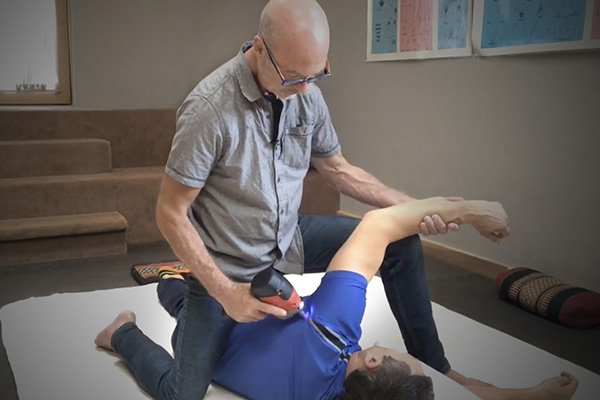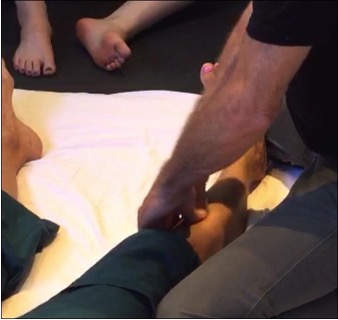
The following blog post is sponsored by Coaching the Body.
Therapeutic vibration tools have become very popular in recent years. We make extensive use of them within my Coaching The Body® manual therapy approach. And while I’m very excited about the results we get with the use of these tools within the CTB system, there is a lot of misunderstanding regarding the real intent and purpose of vibration/percussion tools in general.
When a muscle is placed under stretch and tapped or strummed in its central fiber area, there is a momentary micro-stretch that happens in those fibers as they bend and release, not unlike what happens when a guitar string is plucked. A recent study has shown that when a muscle is percussed, there is a measurable engagement that is confined to the specific muscle fibers that are tapped, and the intensity radiates out from the site of the tap, which demonstrates that the muscle’s firing is not due to a reflex response from the spindles, but originates within the fibers themselves without a round trip to and from the spinal cord.1

In trigger point therapy, we make use of a phenomenon known as the local twitch response. When snapping palpation or needling is used on fibers containing trigger points, the fibers will show this same spike of engagement. The twitch response is considered a confirmative finding for trigger points, and based on the results of the Botter study,1 it appears to be a greatly amplified version of something that happens in normal muscle tissue as well. This would indicate that the nociceptive chemical milieu of the trigger point adds fuel to the mechanism of firing the fiber after it has been suddenly distorted.
Designing A Percussion Tool for Trigger Point Work
We designed our Muscle Liberator™ heads with a fine tip to localize the percussion to specific fibers. The heads are cast from silicone with varying degrees of firmness, all to some extent forgiving and elastic. The tool has a variable speed trigger, allowing the operator to smoothly vary the percussion rate from 0–2,400 strokes per minute.
I’ve found that the rapid-fire percussion also creates a tremendous amount of neurological distraction. At higher speeds, the vibratory distraction from a percussion tool swamps out other sensations, and in my experience is more effective than even spray and stretch. If you use the Muscle Liberator in the vicinity of the shoulder, the vibration will vibrate the entire region and effectively mask most other referral. Without painful feedback upon movement, the CNS allows painfully contracted taut fibers to lengthen, and a new experience of pain-free movement can happen.
It’s Not the Tool—It’s the Training
Percussion tools and “massage guns” have become popular in recent years. Unfortunately, they are being used primarily as an automated way to “rub where it hurts.” The best tool or technique is doomed to mediocrity or outright failure if you don’t actually know where the pain originates and you just chase the pain.
For example, if someone with sciatica or so-called IT band syndrome uses the tool on the side of their leg, they will likely feel some relief, but it won’t last any longer than foam rolling. Unless they understand the origins of sciatic pain, including the relevant functional relationships and satellite referral patterns, they will essentially be treating a symptom rather than the cause, and the pain will return.
Other tools on the market are sold with much larger heads that are usually quite hard. This makes it impossible to target specific fibers, and great care must be taken not to injure bony landmarks such as the spine. We cast our heads out of forgiving silicone, with narrow tips so they can be used on specific fibers, near bony surfaces, and the pressure we use is relatively light, the goal being to provide micro-stretches and vibratory distraction as hacks to get the CNS to allow taut fibers to release.
To learn more about the Coaching The Body® system and to see our Muscle Liberator™ in action, I would invite you to attend our upcoming free web class for ABMP members. Click here to reserve your seat now.

Chuck Duff, Founder, Coaching the Body
Notes
1. Alberto Botter et al., “The Peripheral Origin of Tap-Induced Muscle Contraction Revealed by Multi-Electrode Surface Electromyography in Human Vastus Medialis,” Scientific Reports 10, no. 1: 2256. https://doi.org/10.1038/s41598-020-59122-z.
Proud Sponsor of the ABMP CE Summit
Want to win a Functional Anatomy CE course from Coaching the Body? Coaching the Body is a proud sponsor of the 2021 ABMP CE Summit event. This online education conference focuses on essential tools for the upper body on day one and the lower body on day two. Don’t miss this opportunity to interact with the course instructors live online, learn tools to help your practice, and connect with your massage and bodywork community! This event—including 6 hours of CE—is free for ABMP members and just $99 for nonmembers!
Register for the Giveaway
Register for the 2021 ABMP CE Summit event and then register for the Coaching the Body giveaway. Your event registration gives you access to all of the presentations and course replays after the event.